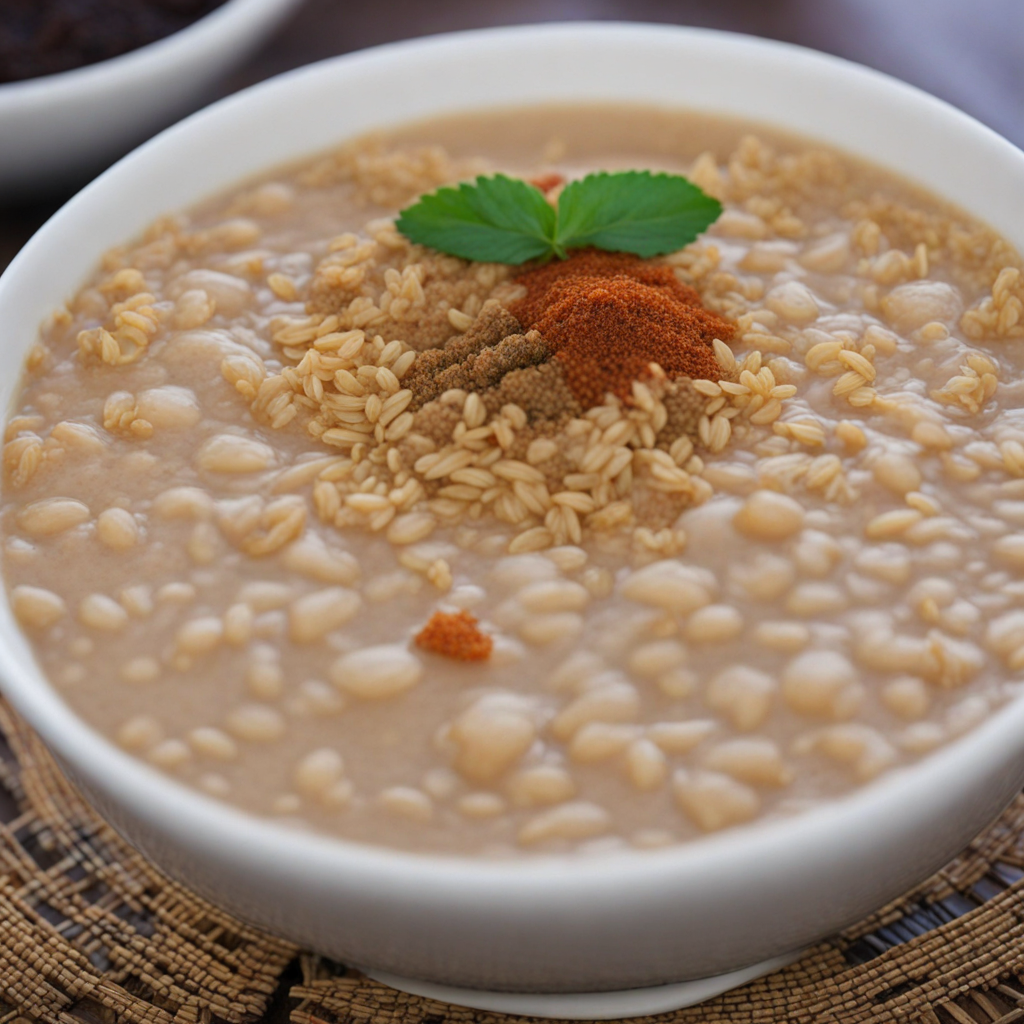Atmit
Atmit is a traditional Ethiopian dish that embodies a unique blend of flavors and textures, offering a delightful culinary experience for those looking to explore new tastes. This nourishing porridge is primarily made from a base of roasted barley flour, which gives it a distinct earthy flavor. The process of roasting the grains before grinding them enhances their nutty aroma, creating a warm and comforting dish that is often enjoyed during breakfast or as a wholesome snack. The texture is smooth and creamy, making it easy to digest and perfect for both young children and adults alike. To elevate Atmit's flavor profile, it is commonly mixed with water or milk, along with a touch of sugar or honey for sweetness. Some variations may include spices like cinnamon or cardamom, adding a subtle warmth that complements the dish beautifully. The versatility of Atmit allows it to be customized according to personal preferences, whether you prefer it sweeter or more savory. Topped with fresh fruits, nuts, or a drizzle of honey, Atmit transforms into a delightful treat that can be enjoyed at any time of the day. In Ethiopian culture, Atmit holds significant nutritional value, often serving as a source of energy and sustenance for many. It is particularly favored for its simplicity and ease of preparation, making it a staple in households. The dish not only offers a taste of Ethiopia's rich culinary heritage but also reflects the country's emphasis on wholesome, natural ingredients. With its comforting consistency and delightful flavor, Atmit is an inviting dish that encourages exploration and appreciation of Ethiopian cuisine.
How It Became This Dish
The History of አትሚት (Atmit) in Ethiopian Cuisine Ethiopian cuisine is a vibrant tapestry of flavors and traditions, deeply intertwined with the country’s history, culture, and agricultural practices. Among the array of traditional dishes, አትሚት (Atmit) holds a special place, often revered for its nutritional value, historical significance, and cultural relevance. This dish, a porridge made from barley or wheat flour, represents not only sustenance but also a connection to Ethiopian identity and heritage. #### Origins of Atmit The roots of Atmit can be traced back to ancient Ethiopia, where agriculture flourished in the highlands. Ethiopia is one of the few regions in the world where the cultivation of grains like barley and teff began independently. Archaeological findings suggest that barley was cultivated in Ethiopia as early as 4000 BCE, making it one of the oldest domesticated crops in the area. This staple grain became integral to the Ethiopian diet, forming the basis of numerous traditional dishes, including Atmit. Atmit is primarily made from roasted barley flour, which is mixed with water or milk to create a smooth, nourishing porridge. The grain’s high nutritional content, including protein, fiber, and essential vitamins, made it a popular choice for both the rural and urban populations. Particularly in times of scarcity or during the rainy season, when fresh produce might be limited, Atmit served as a reliable source of sustenance. #### Cultural Significance of Atmit Atmit extends beyond mere sustenance; it embodies a wealth of cultural significance in Ethiopian society. Traditionally, Atmit is associated with communal bonding and family gatherings. It is often prepared for special occasions, such as holidays, religious ceremonies, and family celebrations, where it is shared among friends and loved ones. The act of preparing and serving Atmit fosters a sense of togetherness, reflecting the Ethiopian value of community. In addition, Atmit has long been a food for the vulnerable and is particularly favored for infants, the elderly, and those recovering from illness. Its easy digestibility and nourishing properties make it an ideal choice for those in need of gentle, restorative food. This aspect underscores the role of Atmit as a symbol of care and nurturing in Ethiopian culture. #### Atmit in Religious Contexts Ethiopia is known for its rich religious heritage, with both Christianity and Islam having deep roots in the nation. Atmit also finds its place in religious contexts, particularly within the Ethiopian Orthodox Tewahedo Church. During fasting periods, when many believers refrain from consuming animal products, Atmit serves as a wholesome alternative that adheres to dietary restrictions. Its preparation and consumption during these times highlight the intersection of food, faith, and tradition in Ethiopian life. #### Evolution Over Time Through the ages, the preparation of Atmit has evolved, adapting to modern tastes and practices while retaining its core identity. Traditionally, Atmit was often prepared using a simple method: roasted barley would be ground into flour, then mixed with water or milk over low heat until a thick, creamy consistency was achieved. Spices such as cinnamon and cardamom were occasionally added for flavor, enhancing the dish’s appeal. In contemporary Ethiopia, Atmit has seen variations and innovations. Urbanization and globalization have introduced new ingredients and methods of preparation. While the traditional barley remains popular, modern recipes may incorporate other grains, such as corn or millet, reflecting a diversification in Ethiopian diets. Additionally, the rise of health consciousness has led to a renewed interest in whole grains and traditional foods, with Atmit being celebrated for its health benefits. Furthermore, Atmit has found its way into the international culinary scene as Ethiopian cuisine garners global attention. Restaurants serving Ethiopian dishes have emerged in various parts of the world, often presenting Atmit as a staple offering. This exposure not only promotes Ethiopian culture but also allows for cross-cultural exchanges, where Atmit can be interpreted and adapted by different culinary traditions. #### Atmit Today: A Culinary and Cultural Revival In recent years, there has been a resurgence of interest in traditional Ethiopian foods, with Atmit at the forefront. As younger generations seek to reconnect with their culinary heritage, Atmit has become a symbol of cultural pride and identity. Home cooks and chefs alike are experimenting with the dish, incorporating local ingredients and flavors while respecting its traditional roots. Moreover, Atmit has been embraced in health-conscious circles due to its nutritional profile. With an increasing awareness of the benefits of whole grains and traditional diets, Atmit has found a place in health-focused menus and lifestyle choices. This trend emphasizes the importance of traditional foods in promoting well-being and sustainability. #### Conclusion Atmit is more than just a porridge; it is a narrative woven into the fabric of Ethiopian history, culture, and identity. From its ancient origins as a staple grain in the Ethiopian highlands to its place in contemporary Ethiopian homes and restaurants, Atmit encapsulates the resilience and adaptability of Ethiopian cuisine. It serves as a reminder of the importance of community, tradition, and nourishment. As Ethiopia continues to evolve, so too does Atmit, adapting to contemporary tastes while maintaining its historical significance. This dish embodies a legacy that transcends generations, symbolizing the enduring connection between food, culture, and identity in Ethiopia. In every bowl of Atmit, there lies a story—a story of heritage, community, and the timeless love for good food.
You may like
Discover local flavors from Ethiopia







